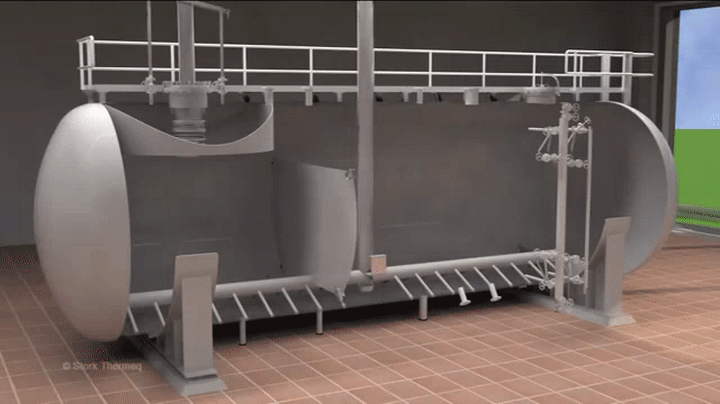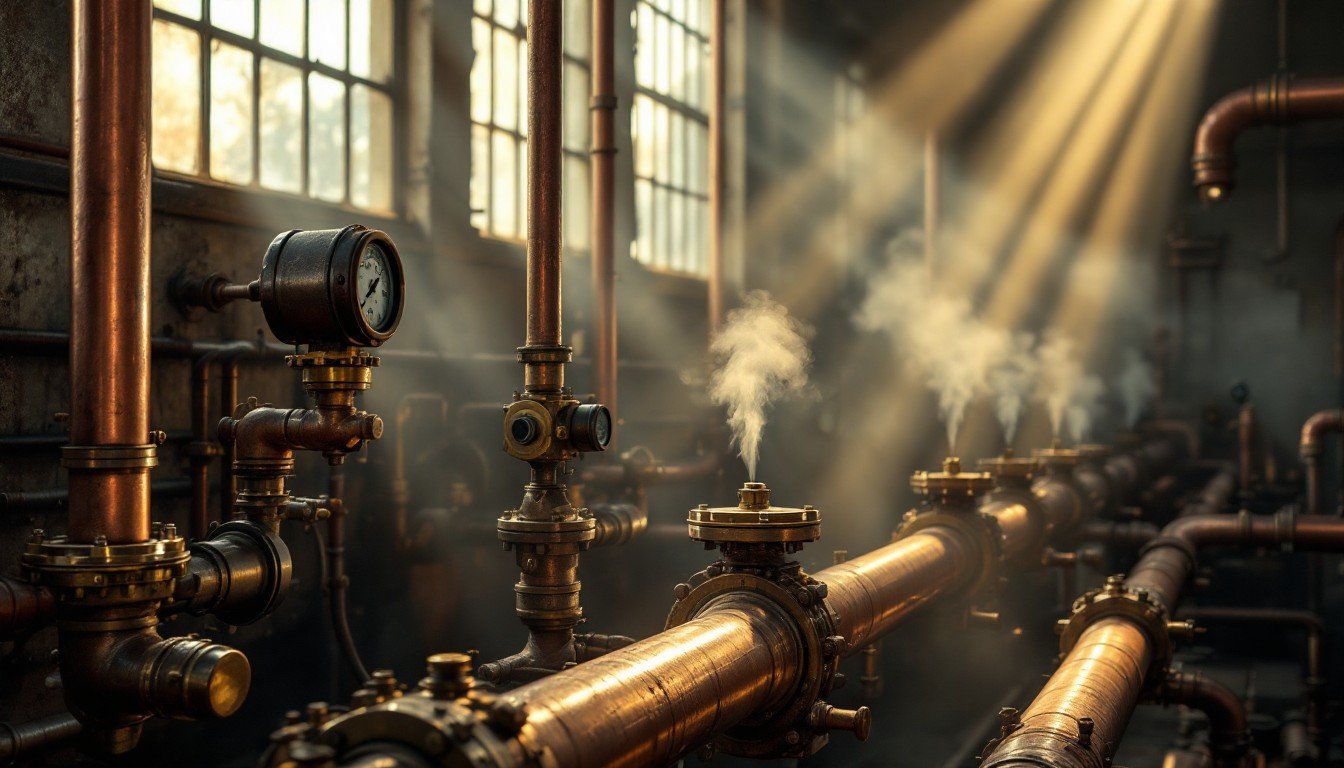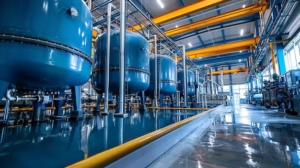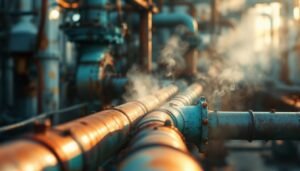Deaerator System Explained: Protecting the Boiler from Within
Introduction: The Role No One Talks About
“It’s just a tank with steam—what’s so special?”
If you’ve ever walked through a power plant or industrial facility, you’ve probably noticed that towering cylindrical vessel sitting quietly between the condensate system and the boiler. Steam rises from its vents, pipes snake in and out of it, and yet it rarely gets the attention it deserves. Most operators and engineers focus on the flashy equipment—the turbines, the boilers, the generators. But this unassuming piece of equipment is working around the clock to prevent what could be catastrophic damage to your entire steam system.
The deaerator system performs one of the most critical yet underappreciated functions in any steam cycle: removing dissolved gases from feedwater and preheating it before it enters the boiler. While it may look simple from the outside, this “silent middleman” carries enormous responsibility. Those dissolved gases—primarily oxygen and carbon dioxide—are invisible enemies that can cause devastating corrosion, pitting, and premature failure of boiler tubes, economizers, and other expensive components.
What Is a Deaerator?
1. Definition
At its core, a deaerator is a specialized device designed to remove dissolved gases—primarily oxygen (O₂) and carbon dioxide (CO₂)—from boiler feedwater while simultaneously raising its temperature before it enters the boiler. Think of it as a dual-purpose treatment system that addresses two critical challenges in one efficient process.
2. Key Functions
- Chemical Protection – By stripping away dissolved oxygen and carbon dioxide, the deaerator system eliminates the primary culprits behind boiler corrosion. Oxygen attacks metal surfaces through oxidation, while carbon dioxide forms carbonic acid that eats away at piping and boiler components. Remove these gases, and you’ve eliminated the chemical warfare happening inside your steam system.
- Thermal Balance – The deaerator heats feedwater to saturation temperature (typically 227°F at atmospheric pressure), preventing thermal shock when the relatively cool condensate meets the high-temperature boiler environment. This temperature conditioning protects boiler tubes from the stress of rapid temperature changes and improves overall system efficiency.
Where the Deaerator Fits in the Steam-Water Cycle
After steam does its work in the turbine, it condenses back into water in the condenser. This water, known as condensate, then goes through Low-Pressure (LP) Heaters where it picks up some heat from extracted steam. But before it can be pumped into the high-pressure boiler, it must go through one last critical checkpoint: the deaerator.
The deaerator sits between the LP heaters and the Boiler Feedwater Pumps (BFPs).
Here’s the typical flow path that water follows through a power plant or industrial steam system:
Condenser → LP Heaters → Deaerator → BFP → Economizer → Boiler
This positioning is no accident. By the time condensate reaches the deaerator, it has already been through initial heating and treatment in the LP heaters. The deaerator system then performs its gas removal and final temperature conditioning before the water gets pressurized by the boiler feedwater pumps and sent through the economizer into the boiler proper. This strategic placement ensures that every drop of water entering your boiler has been properly prepared to do its job without causing damage.
The deaerator essentially acts as the bridge between the low-pressure condensate system and the high-pressure feedwater system—making it one of the most strategically important components in the entire cycle.
Working Principle of a Deaerator
To truly understand how a deaerator system works, imagine you’re watching a carefully choreographed dance between water, steam, and dissolved gases. Here’s what happens inside this seemingly simple vessel, broken down step by step:
1. Preheated Condensate Enters
The journey begins when condensate—already warmed by the LP heaters—flows into the deaerator. This water still carries its invisible cargo of dissolved oxygen and carbon dioxide, picked up during its travels through the condensate system.
2. Steam Enters from Below or Side
Simultaneously, live steam (typically extracted from the turbine or auxiliary steam) enters the deaerator from below or through side connections. This isn’t just any steam—it’s the muscle that will drive the entire deaeration process.
3. Water Sprays Over Trays or Nozzles
Here’s where the magic happens: the incoming condensate is distributed over a series of perforated trays or spray nozzles, creating thin films of water and countless tiny droplets. Think of it like a sophisticated shower system designed to maximize the water’s surface area.
4. Steam Heats Water and Removes Dissolved Gases
As the steam contacts these thin water films and droplets, two critical things occur simultaneously:
- Reducing Solubility: The steam heats the water toward saturation temperature, and here’s the key—hot water simply cannot hold as much dissolved gas as cold water
- Stripping Action: The steam physically sweeps through the water, carrying away the liberated gases like a gentle but persistent wind
5. Gases Escape Through Vent Condenser
The freed gases (along with a small amount of steam) rise to the top of the deaerator and exit through a vent condenser, where they’re safely released to atmosphere. It’s like opening a window to let the unwanted guests leave.
6. Deaerated Water Stored in Storage Tank
The now-clean, hot water collects in the deaerator storage tank (also called the HP feed tank) at the bottom, ready to be pumped to the boiler by the feed pumps.

The Science Behind It: Henry’s Law
The entire process relies on a fundamental principle called Henry’s Law, which states that the amount of gas that can dissolve in water decreases as temperature increases. It’s the same reason a warm soda goes flat faster than a cold one—heat drives out dissolved gases. In the deaerator, we use this natural tendency to our advantage, heating the water to force those corrosive gases to abandon ship.
Types & Main Components of a Deaerator System
1. Types of Deaerators
Not all deaerators are created equal. The design you’ll encounter depends largely on the size and type of facility you’re working in. There are two main configurations, each with its own strengths and ideal applications:
Tray-Type Deaerators are the workhorses of large power plants. These systems use multiple perforated trays stacked inside a horizontal or vertical vessel, creating a cascading effect as water flows from tray to tray while steam rises through the perforations.
Spray-Type Deaerators take a simpler approach, using spray nozzles to atomize the water directly into a steam-filled chamber. You’ll typically find these in smaller industrial plants or where space and complexity need to be minimized.
| Aspect | Tray-Type | Spray-Type |
|---|---|---|
| Design | Multiple perforated trays in horizontal/vertical vessel | Spray nozzles in simple chamber |
| Applications | Large power plants, high-capacity systems | Smaller plants, industrial applications |
| Pros | Higher efficiency, better gas removal, handles large flows | Simple design, lower cost, easier maintenance |
| Cons | More complex, higher initial cost, more maintenance points | Lower efficiency, limited capacity, nozzle plugging risk |
2. Main Components of a Deaerator System
Understanding a deaerator system means knowing its key components and how they work together. Think of it as an orchestra where each instrument has a specific role in creating the final performance.
- Inlet Spray Nozzles / Spray Headers These are the entry points where condensate gets distributed throughout the deaerator. In spray-type units, these nozzles atomize the water. In tray-type systems, the spray headers distribute water evenly across the top tray.
- Trays / Dome (for Tray-Type) The heart of tray-type deaerators, these perforated plates create the intimate contact between water and steam. The dome houses these trays and provides the space for steam-water interaction.
- Steam Inlet Usually connected to LP extraction steam from the turbine, this is where the heating and stripping steam enters the system. The steam flow is carefully controlled to maintain proper temperature and pressure.
- Vent and Vent Condenser The exit route for liberated gases. The vent condenser recovers some of the steam that would otherwise be lost with the non-condensable gases, improving system efficiency.
- Level Transmitters / Control Valves These maintain proper water levels in the storage tank and control steam flow to maintain temperature. They’re the “brain” that keeps everything in balance.
- Deaerator Storage Tank Also called the HP feed tank, this stores the treated water and provides suction head for the boiler feedwater pumps. It’s typically integrated into the bottom of the deaerator vessel.
- Associated Interlocks Safety systems like BFP (Boiler Feedwater Pump) permissive that prevent pump operation if deaerator levels are too low, protecting both the pumps and the boiler from damage.
>>>Deaerators are commonly designed based on industry standards such as those found in the ASME BPVC standards.
Why Deaeration Matters
You might be wondering: “Is all this complexity really necessary?” The answer is an emphatic yes, and here’s why proper deaeration isn’t just important—it’s absolutely critical for your entire steam system’s health and your bottom line.
1. Prevents Pitting & Corrosion in Boiler Tubes and Feed Lines
Dissolved oxygen is like a silent assassin in your steam system. Even tiny concentrations—as low as 7 parts per billion—can cause devastating pitting corrosion in boiler tubes, economizers, and feedwater piping. This isn’t gradual wear; it’s localized attack that can punch holes through metal in surprisingly short timeframes. One failed tube can shut down your entire plant and cost hundreds of thousands in repairs and lost production.
2. Improves Heat Transfer Efficiency
Clean metal surfaces transfer heat far more effectively than corroded or scaled surfaces. When your boiler tubes are free from corrosion products and deposits, heat flows efficiently from the combustion gases to the water. This means lower fuel consumption, reduced emissions, and better overall plant efficiency. Every BTU counts, especially with today’s fuel costs.
3. Reduces Oxygen Scavenger Chemical Dosing
Proper mechanical deaeration dramatically reduces the amount of chemical oxygen scavengers (like sodium sulfite or hydrazine) needed to achieve target dissolved oxygen levels. This isn’t just about chemical costs—it’s about reducing the total dissolved solids in your boiler water, which means less blowdown, less water treatment, and fewer scaling problems.
4. Prevents Thermal Shock in Boiler
When cold feedwater hits hot boiler surfaces, the resulting thermal stress can crack tubes, damage tube sheets, and cause catastrophic failures. By preheating feedwater to saturation temperature, the deaerator system eliminates this thermal shock, protecting your expensive pressure parts and extending their service life.
The deaerator system is your boiler’s shield—fighting corrosion, boosting efficiency, saving chemicals, and preventing temperature-related stress. Ignoring it? That’s a costly mistake.
Common Problems: Troubleshooting Chart
Even the best-designed deaerator systems can develop problems over time. Recognizing the symptoms early and understanding their root causes can save you from costly repairs and unplanned outages. Here’s what to watch for:
1. Oxygen in Feedwater
This is the most critical operational issue because even trace amounts of dissolved oxygen (above 7 ppb) can cause rapid pitting corrosion throughout your steam system. When deaeration fails, oxygen attacks boiler tubes, economizers, and feedwater piping, leading to pinhole leaks, tube failures, and potential catastrophic boiler damage. The cost of repairing oxygen-related damage often exceeds the price of an entire deaerator system.
2. Carryover to Vent
When water droplets get carried out with the vented gases, you’re literally throwing money out the stack. This efficiency problem wastes treated feedwater, increases makeup water costs, and can flood downstream vent condensers. More seriously, excessive carryover indicates poor steam-water separation inside the deaerator, which compromises the entire deaeration process and can lead to water hammer in vent piping.
3. Level Control Issues
Modern deaerators rely heavily on automated level control to maintain proper operation. When level control fails, it creates a cascade of problems: low levels trip boiler feedwater pumps (shutting down the entire unit), high levels cause carryover and flooding, and erratic levels prevent proper deaeration by disrupting residence time and steam-water contact. These automation failures can quickly escalate from minor annoyances to full plant shutdowns.
4. Feed Tank Corrosion
While not immediately critical, long-term corrosion of the deaerator storage tank represents a serious integrity threat. Corrosion products contaminate the feedwater, accelerate wear on boiler feed pumps, and can eventually lead to tank failure. During plant shutdowns, oxygen ingress into empty tanks can cause rapid internal corrosion, making proper layup procedures absolutely essential for tank longevity.
5. Troubleshooting Chart For Common Deaerator Problems
|
Problems 922_279166-81> |
Field Symptoms 922_419c84-b1> |
Typical Causes 922_9a68b0-26> |
Corrective Actions 922_7eb4ba-44> |
|
Oxygen in Feedwater 922_06d881-ec> |
|
|
|
|
Carryover of Water to Vent 922_4afea7-f3> |
|
|
|
|
Level Control Issues 922_d568a0-05> |
|
|
|
|
Corrosion in Feed Tank 922_efe2df-d5> |
|
|
|
Key Takeaway: Most deaerator problems are preventable through proper operation, regular maintenance, and attention to water chemistry. The key is catching issues early before they cascade into major system failures.
Engineering Best Practices
Successful deaerator operation isn’t just about understanding the theory—it’s about implementing proven practices that keep your system running reliably for decades. Here are the essential practices that separate well-run plants from those constantly fighting deaerator problems:
- Monitor Deaerator Pressure & Temperature—Log Regularly: Your deaerator’s pressure and temperature are its vital signs. Establish baseline operating parameters and track them consistently. Sudden changes often indicate developing problems before they become critical. Look for trends, not just absolute values—a gradual pressure drop might indicate steam supply issues or internal fouling.
- Periodic Lab Testing for Dissolved Oxygen: Don’t rely solely on online analyzers. Regular grab samples analyzed in the lab provide the ground truth about your deaerator’s performance. Test dissolved oxygen in the feedwater at least daily during normal operation, and more frequently after maintenance or when operating conditions change. Target levels should be consistently below 7 ppb—anything higher indicates your deaeration process needs attention.
- Inspect Spray Nozzles and Tray Scaling During Overhauls: Internal inspections during planned outages are your window into the deaerator’s health. Check spray nozzles for plugging, erosion, or damage that could affect water distribution. Examine trays for scaling, corrosion, or mechanical damage.
- Check for Continuous Venting—No Vent, No Gas Removal: A properly operating deaerator should always have a visible steam plume from the vent stack during operation. If you don’t see venting, you’re not removing gases. Check vent lines for blockages, ensure vent valves are properly positioned, and verify that the vent condenser isn’t creating excessive back pressure. Remember: the vent is where the “removed” gases actually leave the system.
- Maintain Proper NPSH for BFPs by Ensuring Level and Temperature: Your boiler feedwater pumps depend on the deaerator to provide adequate Net Positive Suction Head (NPSH). This means maintaining both proper water level in the storage tank and saturation temperature of the feedwater. Low levels or temperatures can cause pump cavitation, leading to mechanical damage and flow instability. Monitor these parameters closely and establish clear operating limits that protect your expensive feed pumps.
Conclusion: The Boiler’s Silent Bodyguard
When you walk through your plant tomorrow, take a moment to look at that deaerator with new eyes. It’s not just another tank with steam rising from it—it’s your boiler’s silent bodyguard, working around the clock as both corrosion insurance and thermal stabilizer rolled into one critical system.
Every drop of water that enters your boiler has passed through this guardian, stripped of its corrosive oxygen and carbon dioxide, heated to the perfect temperature, and prepared for its high-pressure mission. Without this preparation, your expensive boiler tubes, economizers, and feedwater systems would be under constant chemical and thermal assault.
Here’s my challenge to you: start paying closer attention to your deaerator unit. Check those pressure and temperature logs. Walk by the vent stack and confirm you see proper venting. Ask your water chemistry team about recent dissolved oxygen trends. Small mistakes in deaerator operation have a nasty habit of becoming big, expensive problems downstream—problems that show up as tube failures, pump damage, and unplanned outages when you can least afford them.
Respect the deaerator—and your boiler will thank you.
~Rotormind




